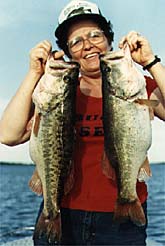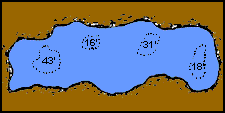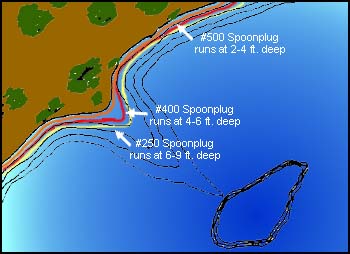|
|

|
 |
 | ||
After Springtime, Fish Deeper Water "If we are to consistently catch big fish wherever we are fishing, we must use underwater features (structure, breaks, breaklines, deep water) as our guide to where fish will be. We must CONTROL the depth and speed of our lures (at the same time) on and/or around these features to catch fish." - Buck Perry
Following the spawn, the fish return to deep water and become rather dormant for a period of time. There is no set time for this "dormant" period, but a good guide is to say it lasts until a deeper section of water warms up. The warming of the deeper water is dependent upon the weather conditions, and can actually change from year to year. For most of the country, it takes five to six weeks before the deeper water warms to the point where the fish really get moving good again. A funny thing happens during this five or six week period. The mass of fishermen put up their tackle for the year, saying it's too hot and the fishing is dead until next spring. Actually following this short "dormant" period, the best fishing of the season begins. Look forward to the hottest, muggiest day of the year. It will be the best fishing day.
Fishing A Natural Lake
If I got no action there, I'd concentrate my efforts in two areas: the section with the 43 foot depth and the section with the 31 foot depth. My first fishing would be to troll completely around each section to establish the bottom conditions and features of each area. I'd use lure sizes (Spoonplugs) and suitable line lengths on the troll to check all depths and speeds as deep as I could go, or as deep as I could detect structure, breaks and breaklines. This would establish the best positions and features for casting which I would use to more thoroughly check out specific spots that looked like possible migration routes to shallow water. On the cast, I'd use a free-running bottom-bumping lure (a Spoonplug) and a "jump type" lure (jig).
Fishing A Reservoir
I would first troll the shallows, the total length of the section. I'd use the first three sizes of Spoonplugs. If these trolling passes did not produce any fish, I would use larger Spoonplugs and work deeper on the area of the ridge-like bar. With each larger size Spoonplug I'd make several passes from several directions. On each pass, I'd get good shoreline sightings so I could repeat the same pass if I caught a fish. I would also throw a marker if I caught a fish since a school might be present. I would check depths to 20 ft or beyond. During the deeper trolling passes, I would place markers to show me the shape and direction of the bar. If the deeper trolling passes did not produce, I'd go to the cast. I would anchor the boat somewhere on the crown of the bar, as indicated by a marker, so I could "fan cast" and reach the extreme shallows (8-10 ft) casting in both directions. I would check out the shallows with two types of lures. First with a free running, bottom bouncing lure (a Spoonplug) on a steady retrieve. If this did not produce, then I'd try the same casts with a "jump type" lure (a jig or plastic worm). I'd work the lure along the bottom, allowing it to return after each jump. If this failed to produce any fish, I'd turn to deeper water and fan cast the crown and sides of the bar using the same two styles of lures. I would cast to deep water reaching the drop off, perhaps re-locating the boat deeper on the bar as I continued testing the deeper waters. If this didn't produce, I'd go to wire line. (See How to Fish Deep Water) If you aren't familiar with using wire line, you should fish another structure and then return periodically to this area to check the structure for any fish movement. I would repeatedly check this structure throughout the day, expecting to at some time to find the fish active and moving. ####
An America Outdoors Feature. All Rights Reserved. |
|
|
| Site design by Outdoor Management Network Inc. Copyright © 1996 - 2007 Outdoor Management Network Inc. America Outdoors® is a registered trademark of Outdoor Management Network Inc. |
 Springtime is always the most popular time of the year to
fish. The spawning season brings fish into shallow water for
spawning. During this season, fish are easy to find, easy to
reach, and relatively easy to catch. Many fishermen only fish
during this time of the year.
Springtime is always the most popular time of the year to
fish. The spawning season brings fish into shallow water for
spawning. During this season, fish are easy to find, easy to
reach, and relatively easy to catch. Many fishermen only fish
during this time of the year. To successfully fish a natural lake, I'd first find the deep
water holes. The figure to the right is a top view of a natural lake that has
four deeper sections. First, I'd troll the shoreline shallows to
get the lay of the land, and see if any fish were shallow.
To successfully fish a natural lake, I'd first find the deep
water holes. The figure to the right is a top view of a natural lake that has
four deeper sections. First, I'd troll the shoreline shallows to
get the lay of the land, and see if any fish were shallow. This is a top view of a section in a reservoir that has
produced fish in the past. If I was going to check out this area
thoroughly, I'd plan to both troll and cast.
This is a top view of a section in a reservoir that has
produced fish in the past. If I was going to check out this area
thoroughly, I'd plan to both troll and cast.